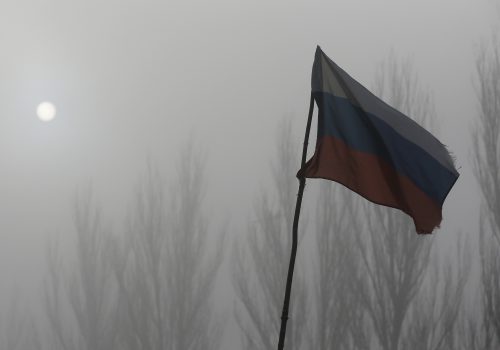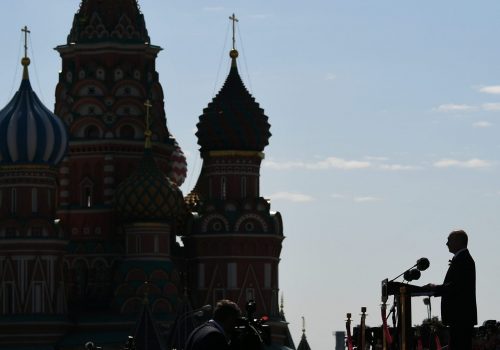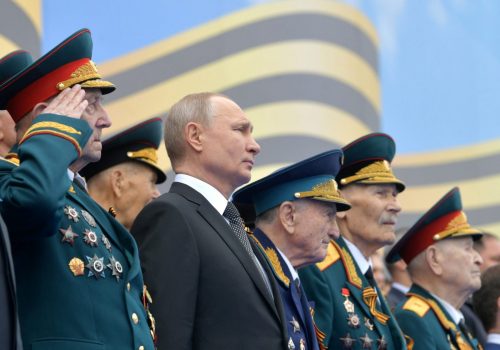The movie “Mr. Jones” is an important new historical drama with a very contemporary context. Released in the US in spring 2020, it sheds long overdue light on one of Stalin’s worst crimes, while also serving as a timely reminder that today’s talk of fake news is actually nothing new.
Written by Andrea Chalupa and directed by the Oscar-nominated director and screenwriter Agnieszka Holland, this joint Polish, Ukrainian, and British production follows one man’s struggle to expose Stalin’s man-made famine in Ukraine, a crime the Soviet regime was desperate to hide from the outside world.
The movie’s central character is Gareth Jones, a young Welsh journalist who travels to the Soviet Union in the early 1930s hoping to interview Stalin. Instead, he ends up uncovering the dictator’s darkest secret, the Ukrainian famine. Jones’s principle antagonist is the Pulitzer Prize-winning New York Times Moscow correspondent Walter Duranty, who uses his considerable status to publicly attack Jones and deny the existence of the famine. The two leading actors, James Norton (Gareth Jones) and Peter Sarsgaard (Walter Duranty), brilliantly capture this struggle for truth during what was one of the darkest periods in European history.
With its focus on the journalistic duel to control the narrative surrounding Stalin’s famine, the movie echoes many of the themes that define today’s information battlefield. In the current era of fake news and alternative facts, “Mr. Jones” demonstrates that previous generations also grappled with similar challenges. It illustrates the grave responsibility of the media to portray events accurately, while capturing the unchanging authoritarian impulse to conceal and distort.
This window on Stalin-era information warfare makes for a highly relevant political drama, but it is as an historical film that “Mr. Jones” really stands out. The movie breaks important new cinematic ground, introducing mainstream international audiences to the 1932-33 Ukrainian famine for the first time. Known to Ukrainians as the Holodomor, the famine was one of the worst atrocities of the twentieth century, but it has yet to enter the global consciousness in a manner befitting the scale and impact of the tragedy.
Stay updated
As the world watches the Russian invasion of Ukraine unfold, UkraineAlert delivers the best Atlantic Council expert insight and analysis on Ukraine twice a week directly to your inbox.
Many viewers will be stunned by the events depicted in “Mr. Jones” and will come away encouraged to explore the subject in further detail. They will soon discover that debate continues to rage over exactly what Gareth Jones witnessed in Ukraine in March 1933.
The film’s suave villain, Walter Duranty, was only the first in a long line of Western journalists, academics, and intellectuals to deny the reality of the famine. This denial has taken on many different forms over the past nine decades. It began with outright refusals to recognize the famine, before later evolving into attempts to reject the deliberate character of the mass starvation and refute the targeting of Ukrainians.
Since the collapse of the Soviet Union, the discussion has centered on whether the Holodomor qualifies as an act of genocide against the Ukrainian nation. This was the definition given to the famine by no less an authority than Raphael Lemkin, the lawyer who coined the term “genocide”. Nevertheless, there is still considerable resistance to recognizing the Holodomor as genocide. Tellingly, the ongoing debate over recognition tends to be primarily political rather than academic in nature.
What exactly did Gareth Jones encounter in Ukraine? In March 1933, the young Welshman boarded a train in Moscow bound for Kharkiv, which was then the capital of Soviet Ukraine. As the train drew close to the Russia-Ukraine border, he disembarked surreptitiously and continued his journey on foot. While he reported evidence of food scarcity on the Russian side of the border, it soon became clear that Ukraine was in the midst of a vast and deadly famine.
“In almost every village, the bread supply had run out two months earlier, the potatoes were almost exhausted, and there was not enough coarse beet, which was formerly used as cattle fodder, but has now become a staple food of the population, to last until the next harvest,” Jones wrote a few weeks later in a letter to the editor of the Manchester Guardian newspaper [the forerunner of today’s Guardian newspaper – Ed.]. “In each village I received the same information – namely that many were dying of the famine and that about four-fifths of the cattle and the horses had perished. One phrase was repeated until it had a sad monotony in my mind, and that was: “Vse opukhli” (“all are swollen from hunger”), and one word was drummed into my memory by every talk. That word was “golod”, meaning “hunger” or “famine”. Nor shall I forget the swollen stomachs of the children in the cottages in which I slept.”
Upon leaving the Soviet Union in late March 1933, Jones issued a press release about his recent experiences in what he called the “black earth region” of the Soviet Union. It was picked up by several newspapers, but not the New York Times. Others proved equally unwilling to accept reports of the famine. For ideological or other reasons, many of those who were sympathetic towards the Soviet Union did not want to hear about people dying of hunger in the fledgling socialist paradise. The chorus of denials included some of the intellectual heavyweights of the age such as George Bernard Shaw, who signed a collective letter to the Manchester Guardian which accused the British media of presenting “the condition of Russian workers as one of slavery and starvation.”
The main rebuttal to Jones came from Duranty himself via an article published in the March 31, 1933 edition of the New York Times. This masterpiece of disinformation directly attacked Jones, accusing him of jumping to conclusions on the basis of limited facts and not telling the entire story. “Conditions are bad but there is no famine,” wrote Duranty.
While dismissing talk of mass starvation, Duranty echoed Soviet propaganda by acknowledging “food shortages” due to mismanagement and sabotage within the agricultural collectivization process. Notoriously, the New York Times correspondent also shared his own thoughts on the situation in Ukraine. “To put it brutally, you can’t make an omelet without breaking eggs,” he wrote. This chilling line appears in “Mr. Jones”. It is perhaps the ultimate testament to the cynicism that allowed Duranty and his fellow Moscow correspondents to cover up the mass murder of millions.
There is no suggestion that Duranty’s denials were ideologically driven. The Liverpool-born journalist was anything but a Communist fellow traveler. His chief motivation in concealing the Holodomor appears to have been a desire to maintain his high standing in Soviet Moscow and protect his access to leading Bolsheviks. By the time of the famine in 1933, Duranty had already achieved considerable international fame for his coverage of the Soviet experiment. He seems to have had few qualms about following the party line as Ukraine starved.
The criticisms leveled at Jones were both ethically and factually dubious. Duranty accused the Welshman of presenting “a rather inadequate cross section of a big country.” In reality, by journeying through the Russian-Ukrainian borderlands and testifying to the different conditions he encountered in Russia and Ukraine, Jones had unknowingly stumbled upon a major characteristic of the Holodomor. Far from being a natural disaster, this was a famine that followed national and political boundaries.
The immediate cause of the famine was Stalin’s drive to gain control over the Soviet Union’s agricultural sector in order to finance his ambitious industrialization and militarization plans. This meant forcing millions of peasants onto collective farms. As resistance to collectivization grew in the late 1920s and early 1930s, agriculturally rich Ukraine became a focal point of peasant uprisings. In response, Stalin deployed the secret police to conduct large-scale deportations while continuing with collectivization and the requisition of grain.
By spring 1932, the removal of grain supplies had led to famine in parts of Ukraine. Within a year, virtually the whole of Ukraine was suffering from mass starvation. Other grain-producing areas of the USSR were also experiencing famine, including the lower Volga region and the Kuban region of the North Caucasus, which was largely settled by Ukrainians.
The available evidence indicates that Stalin used the crisis to crush what he considered to be Ukrainian nationalism, manifested in Ukrainian resistance to collectivization. As a former People’s Commissar for Nationalities, Stalin was well-versed in the intricacies of national identity within the USSR. He believed the cultural accommodation of Ukrainians during the early years of the Soviet Union had strengthened rather than weakened their resistance to the regime. It was an error he sought to correct.
In December 1932, a few months before Jones’s trip to Ukraine and as famine conditions continued to worsen, Stalin launched a major attack on the Ukrainian language and culture. In the regions of Kuban settled by Ukrainians, these measures resulted in the closure of all Ukrainian schools, cultural institutions, and newspapers. Stalin was not only going after Ukrainian grain; he was also targeting Ukrainian culture and, ultimately, Ukrainian identity itself.
In contrast to the parallel collectivization process in Russia, the famine in Ukraine was not restricted to grain-producing regions. The impact of the Holodomor extended to parts of the country that were never considered part of the fabled Ukrainian breadbasket. This included the Kharkiv borderlands of Ukraine that Gareth Jones visited in spring 1933.
Jones’s journey took place prior to the deadliest months of the Holodomor. The death toll in Ukraine would not reach its peak until June 1933. Overall, close to one million people are believed to have died in the Kharkiv region alone. More than half of the estimated four million Ukrainians who lost their lives in the famine perished in regions that did not belong to the country’s grain-producing agricultural heartlands. The only reason these areas suffered so badly was because they were part of Ukraine.
As famine conditions began to recede in late summer 1933, the denials took on a new tone. In an August 1933 article for the New York Times, Duranty belatedly recognized that the “food shortages” cited in his earlier reports had in fact been a large-scale famine. He acknowledged that up to two million people had died, but he refused to attribute this to the actions of the Soviet government. Instead, his focus remained on discrediting opponents while trumpeting the bright future of the USSR. The first sentence of his article read: “The excellent harvest about to be gathered shows that any report of a famine in Russia today is an exaggeration or malignant propaganda.”
This continued whitewashing of Stalin’s Ukraine famine proved internationally convenient. At a time when the democratic world was far more concerned by Hitler’s recent rise to power in Germany and the economic impact of the Great Depression, there was little appetite for a confrontation with the Kremlin.
Indeed, as Ukraine starved, the United States was preparing to extend official recognition to the Soviet Union. Duranty himself was credited with making a significant contribution towards this decision. His Pulitzer Prize-winning coverage of the USSR was widely seen as important in influencing US President Franklin Delano Roosevelt and convincing American public opinion of the need to open diplomatic relations with the communist state.
During a dinner given for Soviet Foreign Minister Maxim Litvinov at New York’s Waldorf-Astoria Hotel in November 1933 to celebrate the establishment of relations between the United States and the USSR, Duranty was greeted with the most thunderous applause of the entire evening. It was a moment of supreme triumph for Stalin’s greatest apologist.
Duranty’s ovation appears in Agnieszka Holland’s movie. The scene serves as a fitting finale to this dramatized account of a previously overlooked chapter in twentieth century history that has much to tell modern audiences about the dangers of disinformation. There can be no Hollywood-style happy endings to films about the Holodomor, but at least the story is now finally being told.
Serhii Plokhii is the Mykhailo Hrushevsky Professor of Ukrainian History and the director of the Ukrainian Research Institute at Harvard University.
Further reading
The views expressed in UkraineAlert are solely those of the authors and do not necessarily reflect the views of the Atlantic Council, its staff, or its supporters.

The Eurasia Center’s mission is to enhance transatlantic cooperation in promoting stability, democratic values and prosperity in Eurasia, from Eastern Europe and Turkey in the West to the Caucasus, Russia and Central Asia in the East.
Follow us on social media
and support our work
Image: James Norton stars as Welsh journalist Gareth Jones in the recently released movie "Mr. Jones", which explores the struggle to reveal the truth about Stalin's man-made famine in 1930's Ukraine. (Photo Courtesy of Samuel Goldwyn Films)





